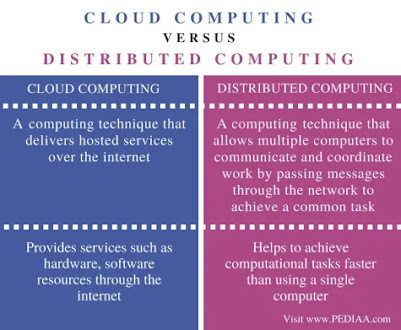Cloud Computing and Distributed Computing are two related but distinct concepts in the field of computer science. While they share similari...
Cloud Computing and Distributed Computing are two related but distinct concepts in the field of computer science. While they share similarities, they differ in their scope, deployment models, and objectives. Let's delve into a detailed comparison of Cloud Computing and Distributed Computing, including their differences, pros, and cons.
 |
| difference cloud computing and distributed computing |
Cloud Computing:
1. Definition:
Cloud Computing refers to the delivery of computing resources, such as servers, storage, databases, software, and services over the internet. It involves the utilization of remote servers hosted on the internet to store, manage, and process data.
2. Deployment Model:
Cloud Computing follows a centralized model where resources are hosted and managed in data centers owned by cloud service providers. Users access these resources remotely via the internet.
3. Scalability:
Cloud Computing offers elastic scalability, allowing users to scale resources up or down based on demand. Cloud providers can quickly allocate additional resources to meet increased demand, ensuring optimal performance and resource utilization.
4. Resource Ownership:
In Cloud Computing, users do not own the physical infrastructure. Instead, they utilize shared resources provided by the cloud service provider. Users pay for the resources they consume based on a subscription or pay-as-you-go model.
5. Accessibility:
Cloud Computing provides ubiquitous access to resources. Users can access their applications and data from any location and device with an internet connection, promoting remote work and collaboration.
6. Pros of Cloud Computing:
- Scalability and flexibility to meet changing demands.
- Cost efficiency, as users only pay for the resources they consume.
- Centralized management and maintenance of infrastructure by the cloud service provider.
- Easy access to a wide range of services and applications.
- Enhanced data security and disaster recovery options provided by the cloud service provider.
7. Cons of Cloud Computing:
- Dependency on internet connectivity for accessing cloud resources.
- Potential concerns over data privacy and security, particularly in sensitive industries.
- Limited control over the underlying infrastructure and customization options.
- Reliance on the performance and reliability of the cloud service provider.
[post_ads]
Distributed Computing:
1. Definition:
Distributed Computing refers to the use of multiple computers or nodes to solve a complex problem or perform a task by dividing it into smaller subtasks. These subtasks are executed concurrently and communicate with each other to achieve a common goal.
2. Deployment Model:
Distributed Computing can be deployed in various ways, including clusters, grids, or peer-to-peer networks. It involves the distribution of computational tasks across multiple nodes or computers, often located in different physical locations.
3. Scalability:
Distributed Computing offers horizontal scalability by adding more nodes to the system to handle increased workloads. The distributed nature of the system allows for efficient resource utilization and improved performance.
4. Resource Ownership:
In Distributed Computing, the resources are typically owned by the individual nodes or organizations participating in the distributed system. Each node contributes its computing power and resources to accomplish the overall task.
5. Accessibility:
Distributed Computing may not provide the same level of ubiquitous access as Cloud Computing. It often relies on network connectivity between nodes, which may require specific configurations and infrastructure to establish communication.
6. Pros of Distributed Computing:
- High performance and increased processing power by leveraging multiple nodes.
- Redundancy and fault tolerance, as tasks can be distributed across multiple nodes, ensuring reliability and availability.
- Flexibility to tailor the system and algorithms to specific requirements.
- Efficient resource utilization and scalability through distributed processing.
7. Cons of Distributed Computing:
- Complexity in designing, implementing, and managing distributed systems.
- Increased communication and coordination overhead between nodes.
- Potential challenges in ensuring data consistency and synchronization.
- Higher upfront costs and resource management complexities compared to using cloud services.
[post_ads_2]
[DASS-167 Meari Tachibana https://mixdrop.co/f/zpwmzv78iod7vo]
Conclusion:
Cloud Computing and Distributed Computing are distinct paradigms, each offering unique advantages and considerations.
Cloud Computing provides centralized, on-demand access to shared resources, scalability, and cost efficiency. On the other hand, Distributed Computing focuses on parallel processing, leveraging multiple nodes for high performance and fault tolerance. Organizations must evaluate their specific needs and requirements to determine which approach aligns best with their objectives and constraints. In some cases, a hybrid approach combining elements of both Cloud Computing and Distributed Computing may offer the most suitable solution for complex computational tasks.
![[feature] Cloud Computing vs. Distributed Computing](https://blogger.googleusercontent.com/img/b/R29vZ2xl/AVvXsEgw7Yq5ifB7rcoA4ptKC5-lmrBSQJe8EwJgOBYc4az5QIHrGBRVNSG7PJwtNs2lAM3mIrEcbRa5Oj5Ku2lhINzfLj8JTNcjyQWj77gCGLXH5AySdoP2_rxKkEHPStAXsSNOvVLyB4a6RhxyCWy9S1SnouP34e8omkZ8UdQ7keQFCKKAAZHVpv-m6S4GQPE/w376-h251/Cloud-Computing-vs-Distributed-Computing.webp)
















COMMENTS